check engine AUDI Q5 2014 Owner's Manual
[x] Cancel search | Manufacturer: AUDI, Model Year: 2014, Model line: Q5, Model: AUDI Q5 2014Pages: 316, PDF Size: 78.41 MB
Page 214 of 316
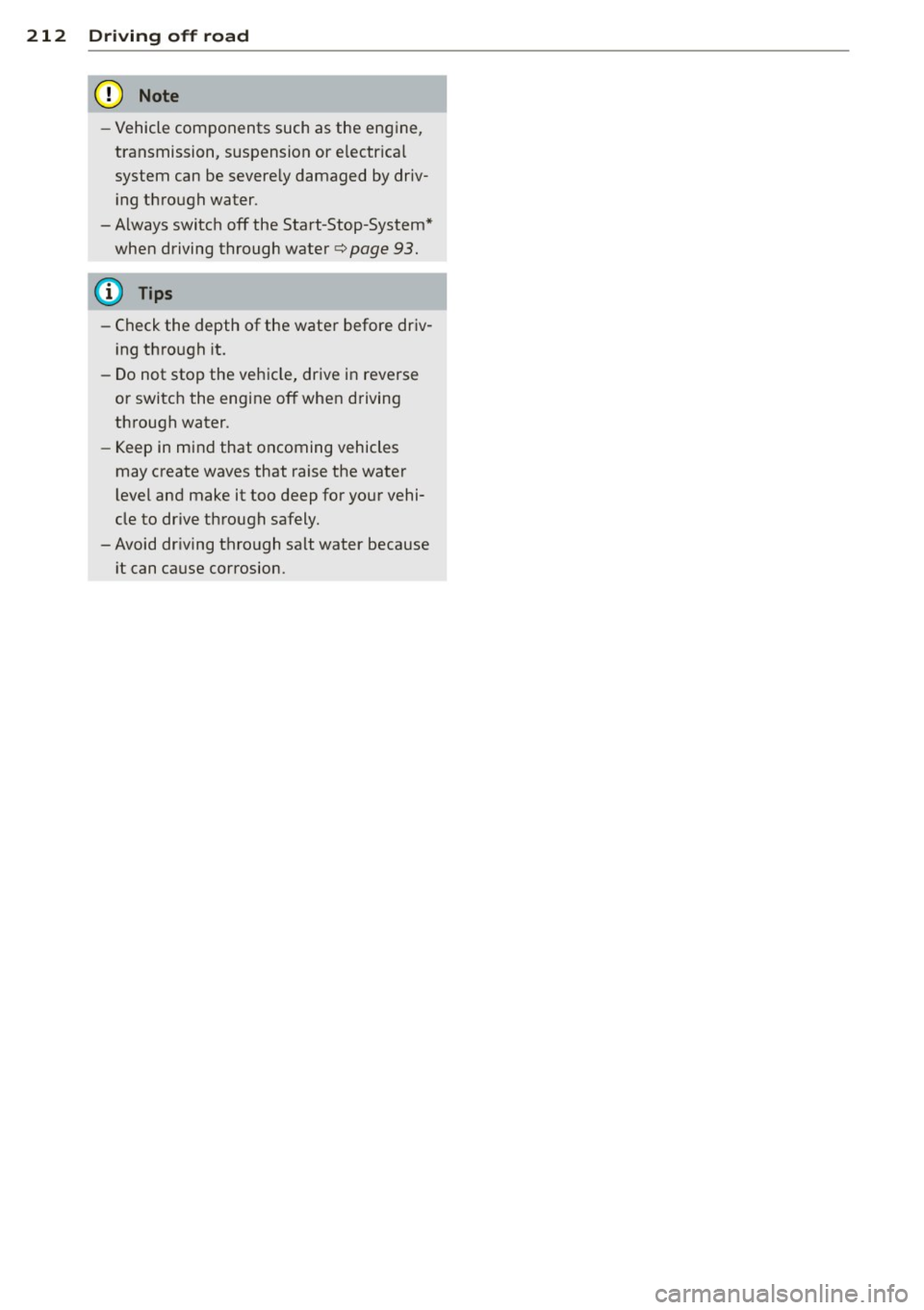
212 Driving o ff road
- Vehicle components such as the engine,
transmission, suspension or e lectr ica l
system can be severe ly damaged by driv
i ng through water .
- Always switch off the Start-Stop-System*
when driving through water
c:> page 93.
@ Tips
-Check the depth of the water before driv
i ng through it.
- Do not stop the vehicle, drive in reverse
or switch the engine off when driving
through water.
- Keep in mind that oncoming vehicles
may create waves that raise the water
level and make it too deep for your vehi
cle to drive through safely.
- Avoid driving through salt water because
i t can cause corrosion.
Page 216 of 316
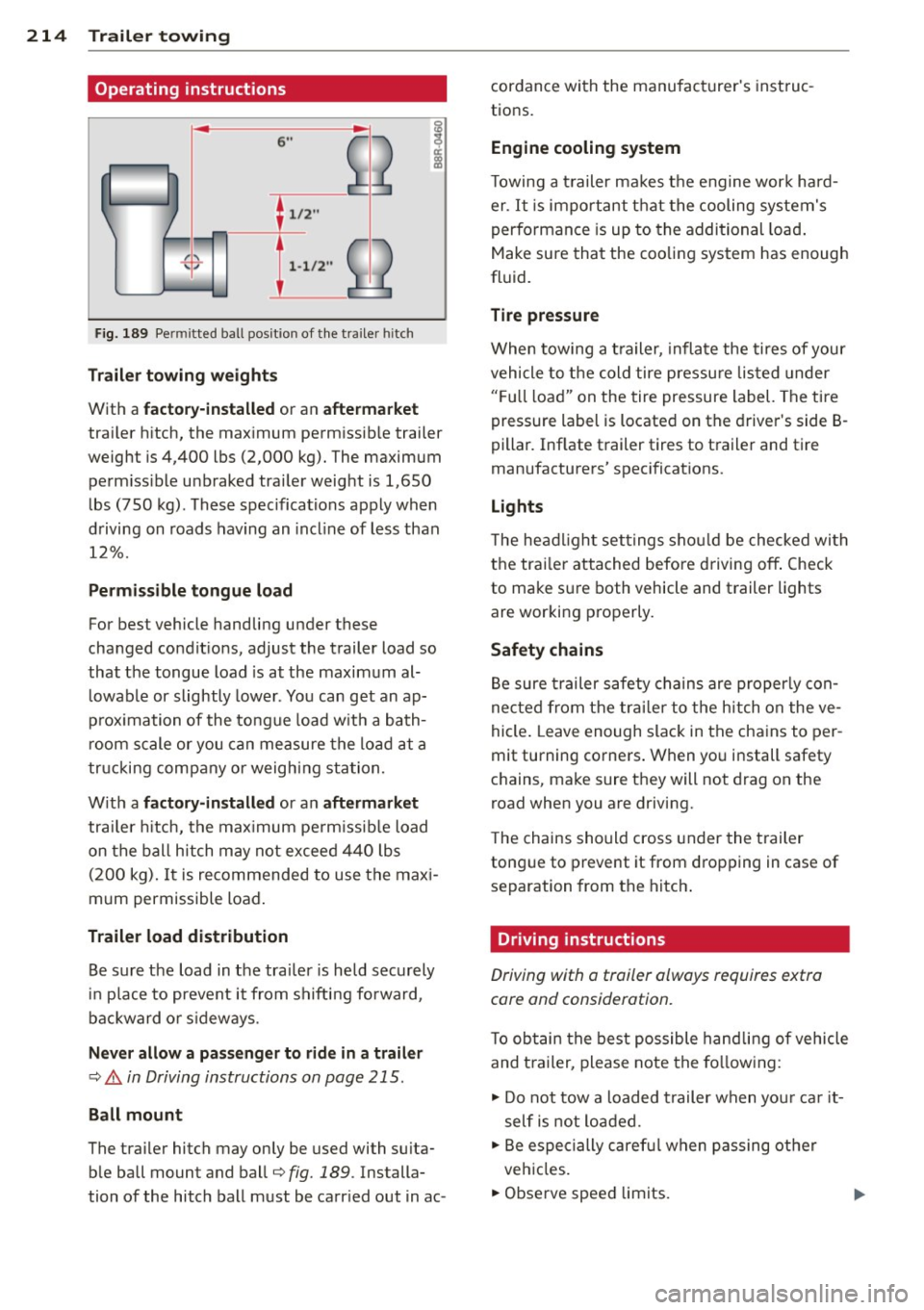
214 Trailer towing
Operating instructions
6"
i ~
I 1,2 ..
{ ~
~
,,
-
2
Fig. 189 Pe rmi tted ball posit ion of the tra iler h itch
T ra ile r tow ing weight s
With a factor y-insta lled or an afte rm arket
trailer h itch, the max imum permissib le trailer
weight is 4,400 lbs (2,000 kg). The maximum perm iss ible unbraked trailer weight is 1,650
lbs (750 kg). These spec ifications apply when
driving on roads hav ing an incl ine of less than
12%.
P erm is s ible tongue load
For best vehicle handling under these
changed condit ions, adjust the trailer load so
that the tongue load is at the maximum al
l owable or slightly lower . You can get an ap
p rox imation of the tongue load w ith a bath
room scale or you can measure the load at a
tr ucking company or weighing sta tion.
W ith a
fact ory -in stall ed or an aftermarket
trailer h itch, the max imum pe rm issible load
on the ball hitch may not exceed 440 lbs (200 kg).
It is recommended to use the maxi
mum permissible load .
Trailer lo ad distribut ion
Be sure the load in the trai ler is held securely
in place to prevent it from shifting fo rward,
backward or s ideways.
N eve r allow a p assenger to rid e in a trail er
¢ .&. in Driving instructions on page 215.
Ball mount
The trailer hitch may only be used with su ita
ble ball mount and ball¢
fig. 189. Installa
tion of the hitch ball must be carr ied out in ac- cordance with the manufacturer's instruc
tions.
Eng ine cooling system
T owing a t railer makes the engine work hard
er . It is important that the cooling system's
performance is up to the additional load .
Make sure that the cooling system has enough
fluid.
Tire pressur e
When towing a trailer, inflate the tires of your
vehicle to the cold tire pressu re listed under
" F u ll load" on the tire pressure label. The tire
pressure label is located on the driver's side B·
pillar. Inflate trailer tires to trailer and tire
manufacturers' spec ificat ions.
Lights
T he headlight settings shou ld be checked wi th
the trai ler attached before driving off . Check
to make sure both vehicle and trailer lights
are working properly.
Safety chains
Be sure trailer safety chains are properly con
nected from the tra iler to the hitch on the ve
hicle . Leave enough slack in the chains to per
mit turning corners . When you install safety
chains, make sure they will not drag on the
road when you are driving.
T he chains should cross under the trailer
tongue to prevent it from dropping in case of separation from the hitch .
Driving instructions
Driving with a trailer always requires extra
core and consideration.
T o obtain the best possible handling of vehicle
and t railer, please note the fo llowing :
.,. Do not tow a loaded t railer when you r ca r it
self is not loaded .
.. Be especially caref ul when passing ot her
vehicles.
.. Observe speed limits.
Page 226 of 316

224 Fuel supply and filling your fuel tank
-Inform yo ur au tho riz ed A udi d ealer t hat
you are operating or have operated the
vehicle with E85 .
- Rea d and follow t he informat ion a nd tips
abo ut gasoline
¢ page 222 .
@ Tips
It may take longer to star t the engi ne
w hen t he outside tempe rat ure is very cold.
I f p ossi ble, use wi nterized fue l if tempera
tures are below freez ing.
Gasoline additives
App lies to vehicles: with gasoline engine
A major concern among many auto manufac
turers is carbon deposit build-up caused by
the type of gasoline you use.
A lthough gasoline grades differ from one
manufacturer to another , they have certa in
things in common. All gasoli ne g rades contain
substances that can ca use depos its to co llec t
on vi tal engine parts, suc h as fu el injectors
and inta ke valves . Although most gasoline
b rands include addi tive s to kee p eng ine and
f u e l sys tems clean, they are no t eq ually e ffec
tive.
Au di r eco mmends using TOP TIER Dete rgen t
Ga soline. Fo r more inform ation o n TOP TI ER
D etergen t Gasoline, please go to the off icial
websi te (www. to ptie rgas .com) .
Afte r an ex tended pe riod of usi ng i nadequate
f u els, b uilt-up car bon deposi ts can ro b you r
engine o f peak perform ance .
(D Note
-Damage or malf uncti on due to poor fue l
qu ality i s n ot c overed by the A udi
New
Vehicle Limi ted War ranty .
- Do n ot ad d a fter ma rk e t fu el addit ive
p rodu cts to your fue l tank.
Diesel fuel
Applies to vehicles: wit h diese l eng ine
Always use ULSD (Ultra Low Sulfur Diesel) sul
fur content 15 ppm or less .
The ULSD (Ultra Low Sulfur Diese l) meets the
ASTM-D-97S (grade 2).
Die sel fuel with a higher con cent ration than
ULSD-Diesel No. 2 ASTM D9 75 and Bio-die
sel with a higher concentrat ion than 5
% like
Bl 1, B20 or B100 are strictly prohib ited.
Se rv ice stat ion fue l pum ps a re labe led with
the correct fuel information for easy recogn i
t ion by t he user. If the d iesel fuel pump is not
l abeled ask the station operator what fuel is
being dispensed before filling up you r vehicle.
Se rv ice stat ions offering Diese l fue l are gener
ally located on t ruck routes or major high
ways. Directories of Diesel f uel stat io ns are
u sua lly available at D iese l fuel stations .
Some states in the USA req uire permits to
purchase Diesel fuel. Check with your State
Motor Vehicle Department .
Diesel f uel may not be ava ila bl e outside t he
U SA and Canada. Be s ure to check before trav
eling to other countries.
Winter operation
At tempe ratu res be low 20° F (- 7° C), Diesel
fuel No. 2 loses its fluidity due to wax sepa ra
t ion, w hich may clog the fue l fi lter or tank fi l
ter and keep the eng ine from runn ing .
T o he lp the filte r from bei ng clogged by wax,
t h e f ue l fi lter in yo ur vehicle is automatically
preheate d. Pre heat ing t he f uel fi lter makes
operation of your vehicle poss ible with D iese l
fuel No. 2 down to -10° F (-24° C) .
If you expect temperatures below 5° F
( - 15° C) ask your fue l dea ler whether thei r
Diesel f uel N o. 2 is s uff icient ly w interized for
the prevailing and expected temperatures.
If not winter ized o r ins uff ic ient ly w interized
Diesel f uel has already thickened to t he extent
t h at the engine wi ll not start, warm the vehi -
cle up by leav ing it in a heated garage.
II>
Page 228 of 316
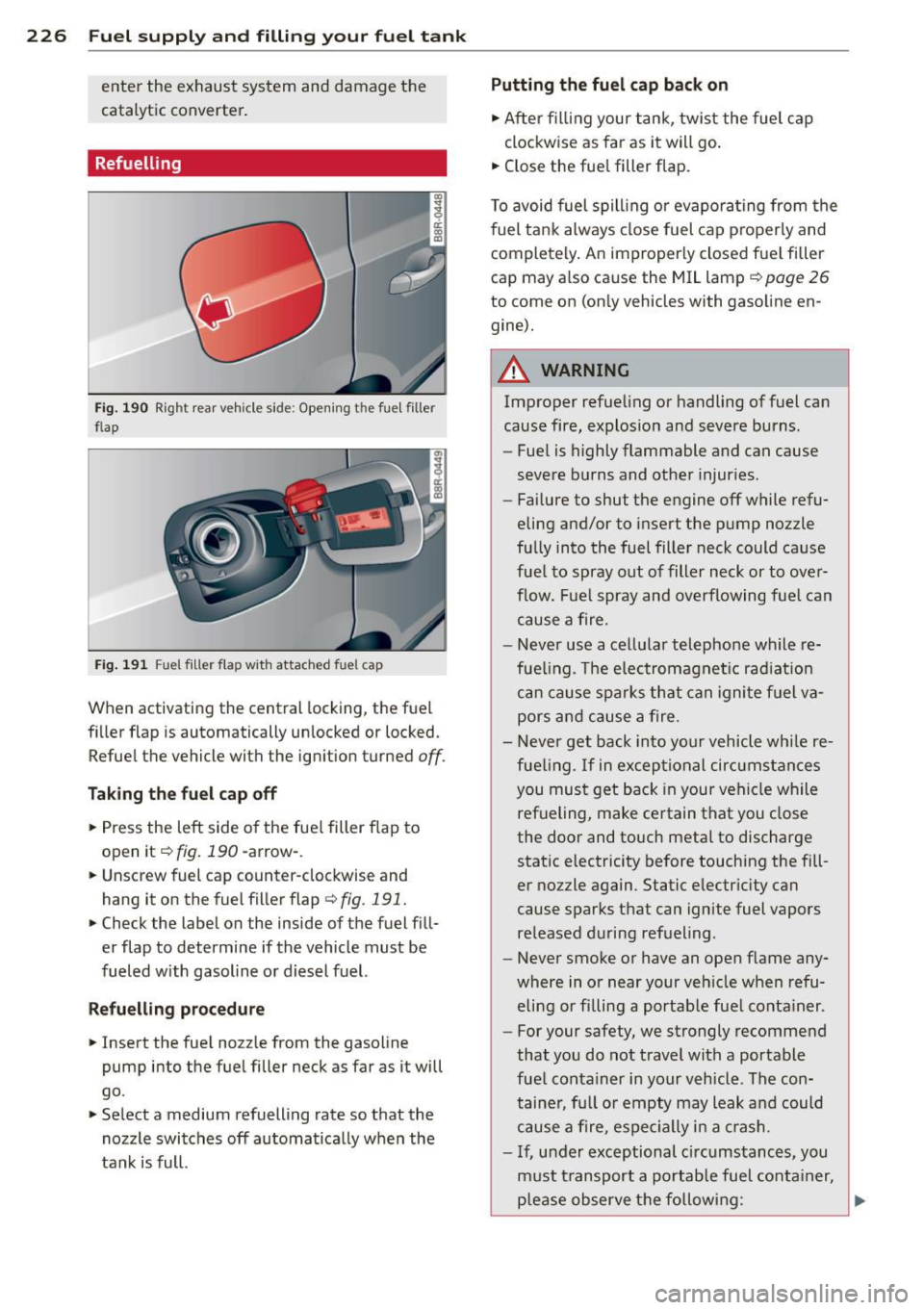
226 Fuel suppl y and filli ng your fu el t ank
enter the exhaust system and damage the
catalytic converter.
Refuelling
Fig. 190 Righ t rear ve hicle si de: Opening t he fuel filler
fl ap
Fig . 191 Fu el filler fla p w ith attached fuel cap
When activating the central locking, the fuel
filler flap is automatically unlocked or locked.
Refuel the vehicle with the ign ition turned
off .
Tak ing th e fu el cap off
• Press the Left side of the fue l filler flap to
open it ¢
fig. 190 -arrow-.
.. Unscrew fuel cap counter-clockwise and
hang it on the fuel filler flap ¢
fig. 191.
.. Check the Label on the inside of the fuel fill
er flap to determine if the vehicle must be
fueled with gasoline or diesel fuel.
Ref uelling pr ocedu re
.. Insert the fue l no zzle from the gasoline
pump into the fuel filler neck as far as it will
go .
.. Select a medium refuelling rate so that the
nozzle switches off automatically when the
tan k is full .
Putting the fu el cap b ack o n
• After f illing your tank, twist the fuel cap
clockwise as far as it will go .
.. Close the fue l filler flap.
T o avoid fuel spill ing o r evaporating from the
fuel tank always close fuel cap p roperly and
completely . An improperly closed fuel filler
cap may a lso ca use the
MIL Lamp ¢ page 26
to come on (on ly vehicles with gasoline en
gine).
A WARNING
-Improper refueling or handling of fuel can
cause fire, explosion and severe burns .
- Fuel is highly flammable and can cause
severe bu rns and other injur ies.
- Failure to shut the engine off while refu
eling and/or to insert the pump nozzle
fully into the fuel filler neck could cause
fuel to spray out of filler neck or to over
flow. Fue l spray and overflowing fuel can
cause a fire .
- Never use a cellular telephone while re
fue ling. The electromagnet ic rad iat ion
can cause spa rks that can ignite f uel va
pors and cause a fire .
- Never get back into your vehicle whi le re
fue ling.
If in exceptional circ umstances
you must get back in your vehicle while
refueling, make certain that you close
the door and touch metal to discharge
static e lectricity before touching the fill
er nozzle again . Static e lectr icity can
cause sparks that can ignite fuel vapors
released du ring refueling .
- Never smoke or have an open flame any
where in or near your vehicle when refu eling or filling a portable fuel conta iner.
- For your safety, we strongly recommend
that you do not travel with a portable
fuel conta iner in your vehicle . The con
tainer, fu ll o r empty may leak and could
cause a fire, especially i n a c rash.
- If , under exceptional c ircumstances, you
must transport a portab le fuel conta iner,
p lease observe the following: .,.
Page 233 of 316

Checking and filling Engine hood
Releasing the engine hood
The engine hood is released from inside the
vehicle .
Fig. 196 Dr iver's side footwell: engin e hood release
lever
"' Open the driver's door .
"' Pull the release lever on the left under the
instrument panel
i=> fig. 196 in the d irection
of the arrow .
The hood pops up slightly under spring pres
sure.
Opening the engine hood
F ig . 197 Release lever under the engine hood
Before opening the engine hood, make sure
that the windshield wipers are flat against the
windshie ld. Otherwise, they could damage the
paint on the hood.
"' Pull up on the release under the hood
r::!> fig . 197 . This releases the catch.
"' Open the hood all the way
i=> .&,.
Checkin g and fillin g 231
A WARNING
Hot engine coolant can burn you.
- To reduce the risk of being burned, never
open the hood if you see or hear steam
or coolant escaping from the eng ine
compartment . Wait unt il no steam or
coolant can be seen or heard before care
fu lly opening the hood.
Closing the engine hood
"' Pull the hood down until the pressure from
the struts is reduced.
"' Let the hood
drop down and latch in p lace.
Do not try to push it shut; it may fail to en
gage
c;, .&, .
A WARNING
--
A hood that is not completely latched
could fly up and block your view while dr iv
ing.
- When you close the engine hood, check it
to make sure the safety catch has proper
ly engaged. The hood should be flush
with the surround ing vehicle body parts.
- If you notice while driv ing that the hood
is not secured properly, stop at once and
close it .
Working in the engine compartment
Be especially careful whenever you work in
the engine compartment.
Whenever yo u must pe rform any w ork in the
e n g ine com pa rt ment, for e xample ch ecki ng
and filling different fluids, th ere is a risk of
injury , burn s and accid ent s. T o pr eve nt per
so nal injury alwa ys obs erve the foll owing
WARNINGS . The en gine c ompa rtment of an y
vehicl e is a hazardou s are a
c;, Lh,.
A WARNING ~
To help avoid injury, be fo re you check any
thing under the hood:
- Turn off the engine.
- Remove the ignition key.
Page 234 of 316

232 Checking and filling
-Apply the parking brake.
- Move selector lever of automatic trans- mission to P (Park).
- Always let the engine cool down. Hot components will burn skin on contact.
- To reduce the risk of being burned, never
open the hood if you see or hear steam
or coolant escaping from the engine
compartment. Wait until no steam or
coolant can be seen or heard before care
fully opening the hood.
- Keep children away from the engine com partment.
- Never spill fluids on hot engine compo
nents. They can cause a fire.
- Never touch the radiator fan. The auxili
ary electric fan is temperature controlled
and can switch on suddenly.
- Never open the coolant reservoir cap
when the engine is still warm. The cool
ant system is pressurized and hot cool ant could spray out .
- Protect your face, hands and arm from
steam or hot engine coolant by placing a
thick rag over the cap when you open the
coolant reservoir .
- Do not remove the engine cover under
any circumstances. This increases the
risk of burns.
- If work on the fuel system or the electri
cal system is necessary:
- Always disconnect the battery.
- Never smoke or work near heaters or
open flames. Fluids in the engine com
partment could start a fire.
- Keep an approved fire extinguisher im
mediately available.
- To avoid electrical shock and personal in
jury while the engine is running or being
started, never touch:
- Ignition cables
- Other components of the high voltage
electronic ignition system.
- If you must perform a check or repair
with the engine running: -
First, fully apply the parking brake,
move selector lever of automatic trans
mission to P (Park).
- Always use extreme caution to prevent
clothing, jewelry, or long hair from get
ting caught in the radiator fan, V-belts
or other moving parts, or from contact ing hot parts. Tie back hair before
starting, and do not wear clothing that
will hang or droop into the engine.
- Minimize exposure to emission and
chemical hazards
c:> &, .
&_ WARNING
California Proposition 65 Warning:
- Engine exhaust, some of its constituents,
and certain vehicle components contain
or emit chemicals known to the State of
California to cause cancer and birth de
fects and reproductive harm. In addition,
certain fluids contained in vehicles and
certain products of component wear con
tain or emit chemicals known to the
State of California to cause cancer and
birth defects or other reproductive harm.
- Battery posts, terminals and related ac
cessories contain lead and lead com
pounds, chemicals known to the State of
California to cause cancer and reproduc
tive harms. Wash hands after handling.
(D Note
When adding fluids, always make sure that
they are poured into the proper container
or filler opening, otherwise serious dam
age to vehicle systems will occur.
@ For the sake of the environment
To detect leaks in time, inspect the vehicle
floor pan from underneath regularly. If
you see spots from oil or other vehicle flu
ids, have your vehicle inspected by an au
thorized Audi dealer.
Page 235 of 316
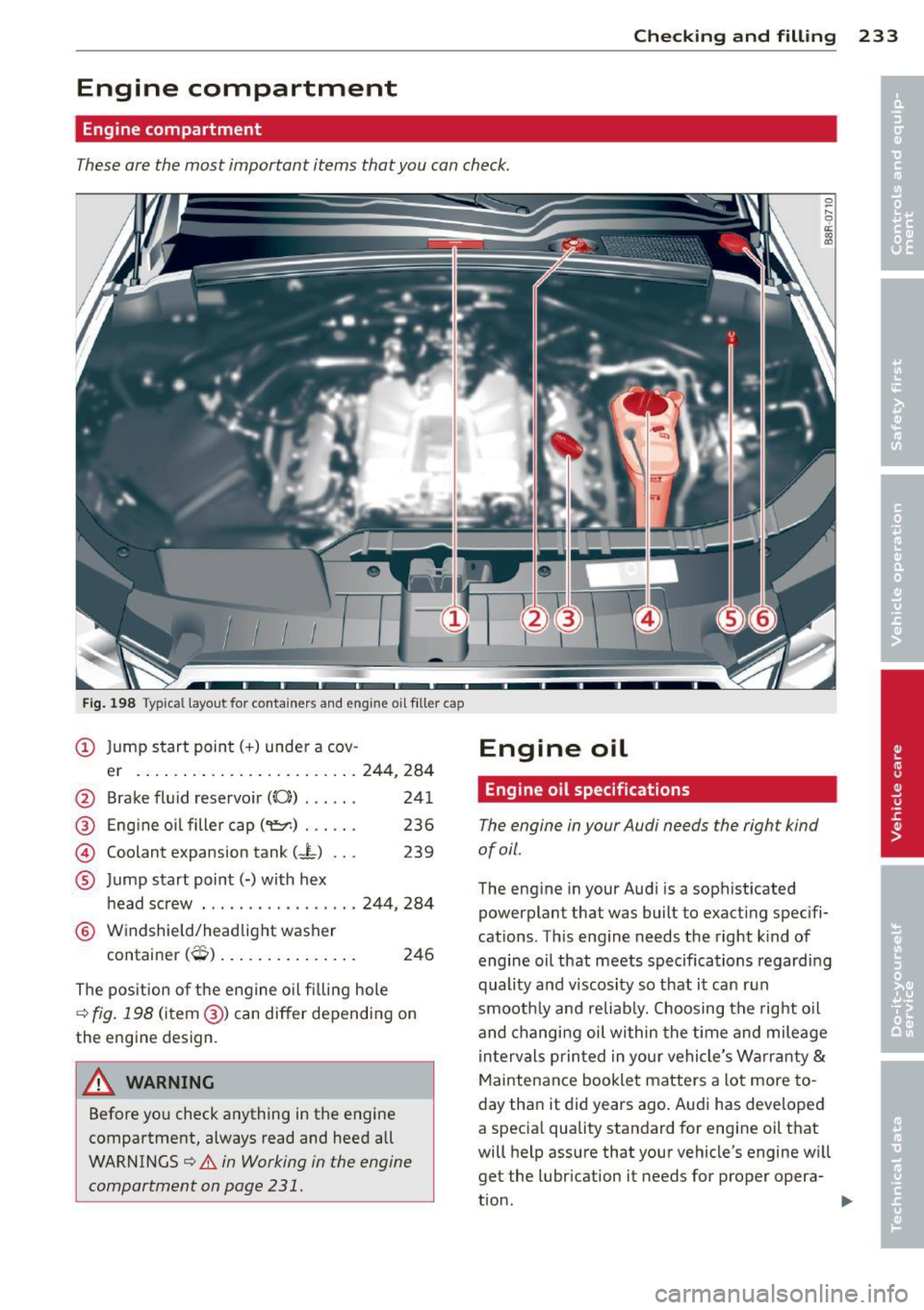
Checking and filling 233
Engine compartment
Engine compartment
These are the most important items that you can check.
Fig. 198 Typical layout for contain ers and engine oil filler cap
(D Jump start point( +) under a cov -
er .. .. .. .. .............. .. 244, 284
@ Brake fluid reservoir ((0)) . . . . . . 241
@ Eng ine oil filler cap ("t=:?1) . . . . . . 236
@ Coolant expansion tank (J-) . . . 239
® Jump start point(-) with hex
head screw ..... .......... ..
244, 284
® Windshield/headlight washer
container
(0) . . . . . . . . . . . . . . . 246
The pos ition of the engine o il filling hole
¢ fig. 198 (item @) can differ depending on
the engine design.
A WARNING
-
Before you check anything in the engine
compartment, always read and heed all
WARNINGS ¢&.
in Working in the engine
compartment on page 231.
Engine oil
Engine oil specifications
The engine in your Audi needs the right kind
of oil.
The engine in your Audi is a sophisticated
powerplant that was built to exacting specifi
cations. This eng ine needs the right k ind of
engine oil that meets specifications regarding
quality and viscosity so that it can run
smooth ly and reliab ly. Choosing the right oil
and changing oil within the time and mileage
intervals printed in your vehicle's Warranty
&
Maintenance booklet matters a lot more to
day than it did years ago . Audi has developed
a specia l quality standard for engine oil that
will help assure that your vehicle's engine will
get the lubrication it needs for proper opera-
tion. .,..
Page 236 of 316
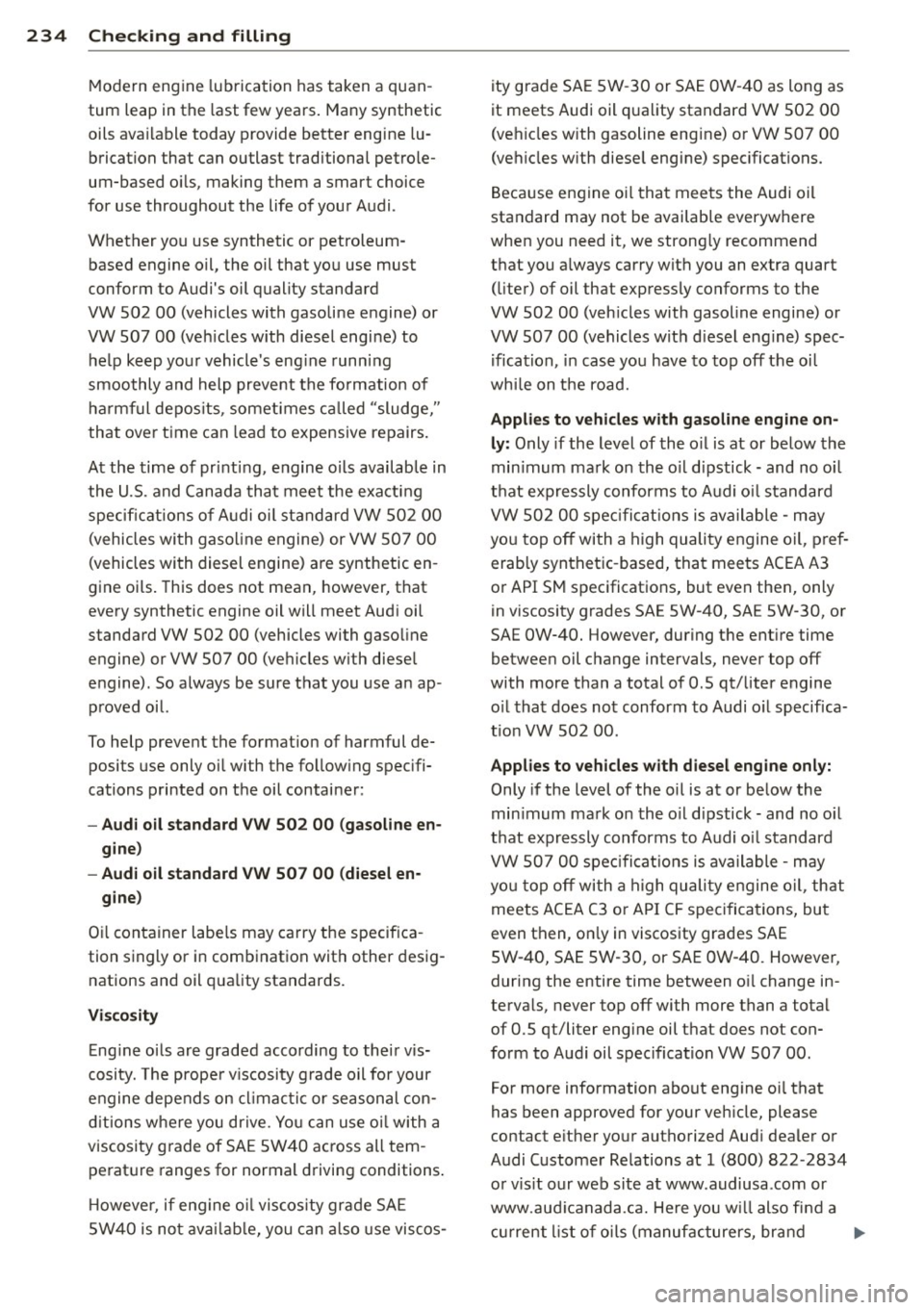
234 Check ing and filling
Mo dern engine lubrication has taken a quan
tum leap in the last few years. Many synthetic
oils ava ilable today provide better engine lu
brication that can outlast traditional petrole
um-based oils, making them a smart choice
for use throughout the life of your Audi .
Whether you use synthetic or petroleum
based engine oil, the oil that you use must
conform to Audi 's oil quality standard
VW 502 00 (vehicles with gasoline engine) or
VW 507 00 (veh icles with diesel engine) to
he lp keep your vehicle's eng ine running
smoothly and help prevent the fo rmation of
harmf ul depos its , somet imes ca lled "sludge,"
that over t ime can lead to expensive repairs.
At the time of printing , engine oils availab le in
the U .S . and Canada that meet the exacting
specifi cations of A udi oi l st andard VW 502 00
(vehicles wi th gasoline engine) or VW 507 00
(vehicles with diesel engine) are synthetic en
gine oils . This does not mean, however, that
every synthetic engine oil will meet Aud i oil
standard VW 502 00 (vehicles with gaso line
engine ) or VW 507 00 (veh icles w it h diese l
engine). So always be sure that you use an ap
proved oil.
To help prevent the format ion of harmful de
posi ts use only oi l with the fo llow ing spec ifi
cations printed on the oil containe r:
- Aud i oil standard VW 50 2 00 (ga soline en
gine )
- Audi oil sta nd ard VW 50 7 00 (diesel en -
gine )
Oil container labe ls may carry the specif ica
tion s ingly or i n comb ination with other desig
nations and oil q ua lity standards.
Visco sity
Eng ine oi ls are graded according to thei r vis
cosity. The prope r viscosity grade oil for your
engine depends on climac tic or seasonal con
d itions whe re you drive. You can use oi l w ith a
viscosity g rade of SAE 5W40 across all tem
perat ure ranges for normal driving conditions .
H oweve r, if eng ine o il viscos ity grade SAE
5W40 is not avai lab le, you c an also use viscos- ity grade SA
E 5W -30 or SA E OW -40 as long as
it meets Audi oil q uality standard VW 502 00
(ve hicles w ith gasoline eng ine) or VW 507 00
(veh icles w ith diese l engine) specifications.
Beca use engine o il that meets the Audi oil
sta ndard may not be availab le everywhere
when you need it, we strong ly recommend
that you a lways carry with you an extra qua rt
(liter) of oil tha t express ly conforms to the
VW 502 00 (veh icles with gasoline engine) or
VW 507 00 (vehicles w it h diesel eng ine) spec
i fication, in case you have to top off the oi l
whi le on the road.
App lies to vehicle s with ga soline engin e on
ly:
Only if the level of the o il is at or below the
min imum ma rk on the o il d ipstick· and no oi l
t h at expressly conforms to Audi o il standard
VW 502 00 spe cificat ions is ava ilable -may
you top off with a high quality engine oil, pre f
erab ly synthetic -based, that meets ACEA A3
or API SM specifications, but even then, only
in v iscosity grades SA E SW-40, SA E 5W-30, or
SAE OW-40. However, during the entire time
betwee n oil change intervals, never top off
with more than a total of 0 .5 qt/liter engine
o il that does not conform to Audi o il specifica
t ion VW 502 00 .
Applies to vehicles with diesel engine only:
Only if the level of the oil is at or be low the
min imum ma rk o n the o il dipstick - and no o il
that expressly conforms to Audi o il standard
VW 507 00 spec ificat ions is ava ilable - may
you top off wi th a h igh quali ty engine oil , that
meets ACEA C3 o r API CF specifications, bu t
even then, on ly in viscosity grades SAE
5W-40, SAE 5W-30, or SAE OW-40. However,
during the entire time between o il change in
terva ls, never top off with more than a total
of 0 .5 q t/liter engine oil tha t does not con
form to Audi oil specification VW 507 00 .
For more information about eng ine oi l that
has been approved for your veh icle, please
con tact e ither your au thorized Aud i dealer or
Audi Custome r Re lations at 1 (800) 822 -2834
o r vis it our web site at www.audiusa .com or
www.aud icanada .ca. He re you w ill also find a
c ur rent l ist of oi ls (manufac turers, brand .,.
Page 237 of 316
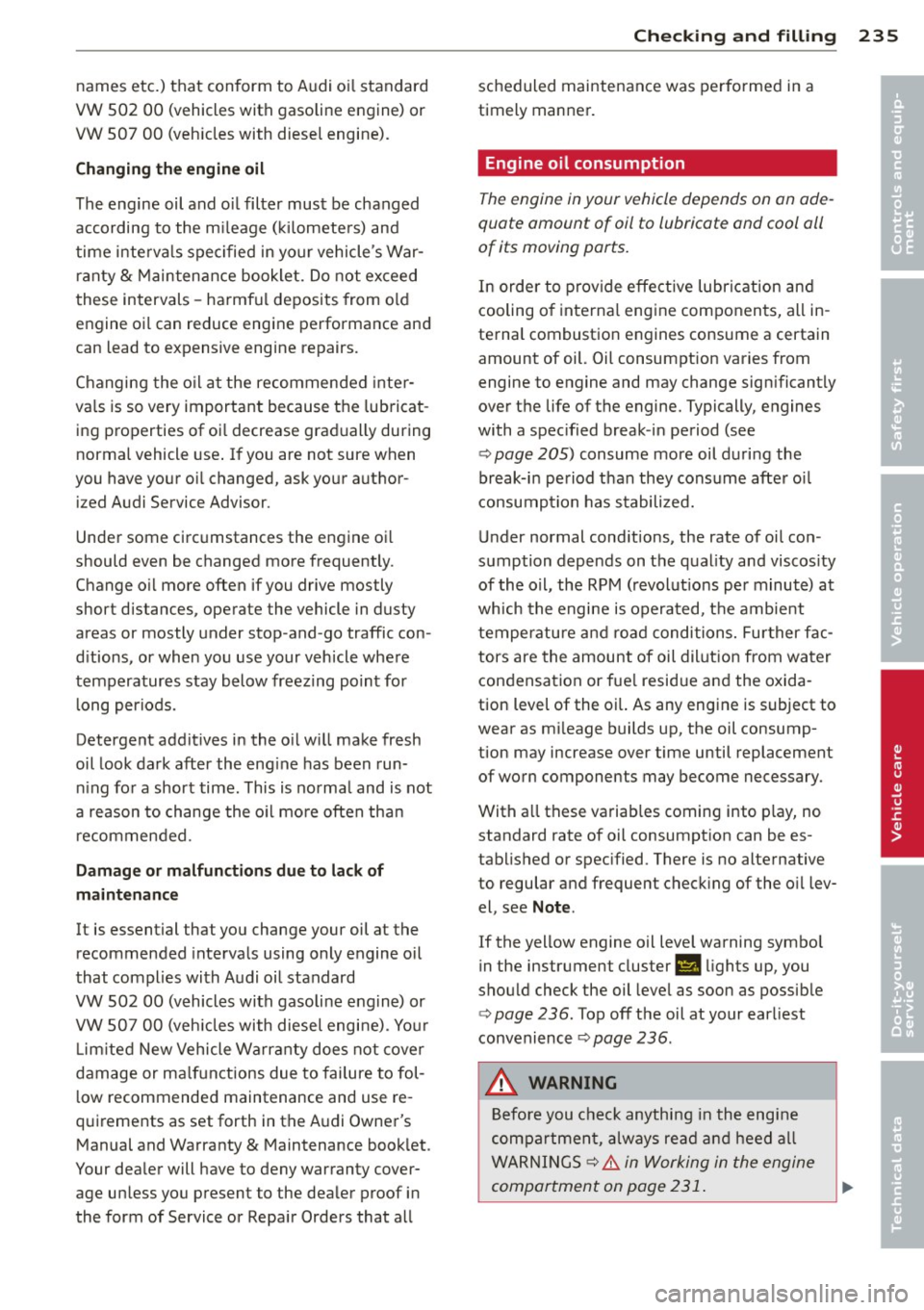
names etc.) that conform to Audi oi l standard
VW 502 00 (vehicles with gasoline engine) or
VW 507 00 (vehicles with diesel engine).
C hang ing th e engin e oil
The engine oil and oi l filter must be changed
according to the m ileage (kilomete rs) and
time inte rva ls specified in yo ur vehicle's War
ranty
& Maintenance booklet. Do not exceed
these intervals -harmful deposits from old
engine oil can reduce engine performance and
can lead to expensive eng ine repairs.
Changing the o il at the recommended inter
va ls is so very important because the lubricat
ing properties of oi l decrease gradually during
norma l vehicle use . If you are not sure when
you have your oi l changed, ask your author
ized Audi Service Advisor.
Under some circ umstances the engine oi l
should even be changed more frequently .
Change o il more often if you drive mostly
short distances, operate the vehicle in dusty
areas or mostly under stop-and -go traffic con
d itions, or when you use your veh icle where
temperatures stay below freezing point for l ong periods.
Detergent addit ives in the o il w ill make fresh
oil look dark after the eng ine has been run
n ing for a short time. This is norma l and is not
a reason to change the o il mo re often than
r ecommended.
Damage or ma lf u nction s du e to lac k of
ma intenance
It is essential that you change your oil at the
recommended interva ls using only engine oil
that complies with Audi oil standard
VW 502 00 (vehicles with gasoline engine) or
VW S07 00 (veh icles with diese l engi ne). Yo ur
L im ited New Vehicle Warra nty does not cover
damage or ma lfunctions due to failure to fol
l ow recommended maintenance and use re
quirements as set forth in the A udi Owner's
Manual and Warranty
& Maintenance book let.
Your dealer will have to deny warranty cover age un less you present to the dea ler proof in
the form of Service or Repa ir Orders that a ll
Checking and fillin g 235
scheduled maintenance was performed in a
timely manner.
· Engine oil consumption
The engine in your vehicle depends on an ade
quate amount of oil to lubricate and cool all
of its moving parts.
In order to prov ide effective lubrication and
cooling o f inte rna l engine components, all in
ternal combustion engines consume a certain
amount of oil. Oil consumpt ion varies from
engine to engine and may change sign ificantly
over the life of the engine. Typically, engines
with a spec ified break-in period (see
Q page 205) consume more oil during the
break-in pe riod than they consume after o il
consump tion has stabilized.
Under normal cond itions, the rate of oi l con
sumption depends on the quality and viscos ity
of the oil, the RP M (revolut ions per minute) at
which the engine is operated, the ambient
tempe rature a nd road conditions. Furt her fac
tors are the amount of oil dilut ion from wa ter
condensation or fue l residue and the oxida
tion level of the oi l. As any engine is subject to
wear as mi leage builds up, the oil consump
tion may increase over time until replacement
of worn components may become necessary.
With a ll these variab les coming into p lay, no
standard rate of oil consumpt ion can be es
tablished or spec ified. There is no alternative
to regular and frequent check ing of the o il lev
el, see
Not e.
If the yellow engine oil level warning symbo l
in the instrument cluster
II lights up, you
shou ld check the oil leve l as soon as possib le
¢ page 236 . Top off the oil at your earliest
convenience
~ page 236.
&_ WARNING
Before you chec k anything in the engine
compa rtmen t, always read and heed al l
WARNI NGS
Q .&. in Working in the engine
compartment on page 231 .
•
•
Page 238 of 316
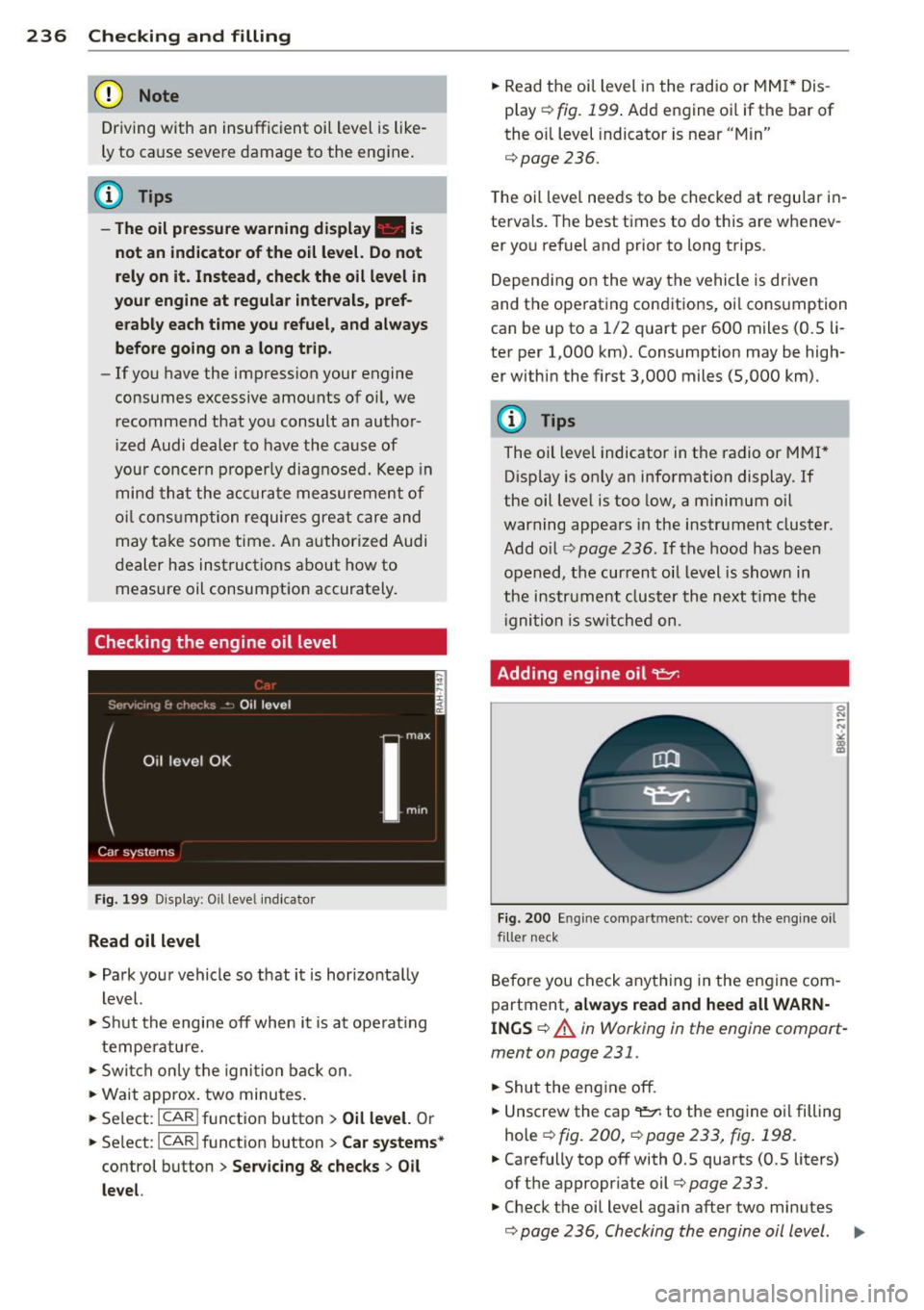
236 Checking and filling
(D Note
Driving with an insufficient oi l level is like
ly to ca use seve re damage to the eng ine.
@ Tips
- The oil pressure warning display. is
not an indicator of the oil level. Do not
rely on it. Instead , check the oil level in
your engine at regular intervals, pref
erably each t ime you refuel, and always
before going on a long trip .
-If you have the impression your engine
consumes excessive amo unts of oi l, we
r ecommend that yo u consult an author
i zed Audi dealer to have the cause of
you r concern p rope rly diag nosed. Keep in
mi nd t hat t he ac curat e measure ment of
oi l co nsu mp tion re q uires grea t care and
may ta ke some time. A n author ize d Audi
dea ler has inst ructions about how to
measure oil consum ptio n accurately.
Checking the engine oil level
Fig . 199 Di splay: O il leve l in dica tor
Read oil level
.. Park you r vehicle so that i t is hor izo nta lly
l evel.
.. Shu t the engine off when i t is at ope ra ti ng
temperature .
.. Swi tch on ly th e igni tion bac k on .
.. Wa it approx. two minutes .
.. Se lect :
I CAR ! funct io n button > Oil level. Or
.. Se lect :
ICAR ! function button> Car systems*
control button > Servicing & checks > Oil
level.
.. Read the oil level in the radio or MM I* Dis
p lay
r=> fig. 199 . Add engine o il if the bar of
the o il level indicato r is near "Mi n"
r=>page236.
The oil leve l needs to be checked at regu lar i n
terva ls. The best times to do this are whenev
er you refuel and prio r to long trips .
D epend in g on the w ay the vehicle is driven
and the ope rat ing cond itio ns, oi l cons umption
can be up to a 1/2 quart per 60 0 miles (O.S li
ter per 1,000 km). Consumption may be high
er withi n the first 3,000 miles (5,000 km).
(!} Tips
The oil leve l indicator in t he radio or M MI*
D isplay is on ly an information display . If
the oil leve l is too low, a m inimum o il
war ning appea rs in the instrument cluster.
A dd oil ¢
page 236. If the hood has bee n
opened , the cur ren t oi l level is shown in
t he i nstr ume nt cl uster the next t ime t he
i gni tion is sw itche d on.
Adding engine oil 't:::r.
Fig. 2 00 Eng ine co mpa rtm ent : cove r on t he e ng in e o il
f il le r ne ck
B efo re you check anyth ing in the en gine com
partment ,
always read and heed all WARN
INGS
¢ A in Working in the engine compart
ment on page 231 .
.. Shu t the eng ine off .
.. Unscrew the cap
9::7; to the eng ine o il filling
hole ¢
fig. 200, r=> page 233, fig . 198 .
.. Carefully top off with 0.5 quarts (0.5 liters)
of t he appropr iate oil¢
page 233.
.. Check the oi l level again after two minutes
¢ page 2 36 , Checking the engine oil l evel. II>